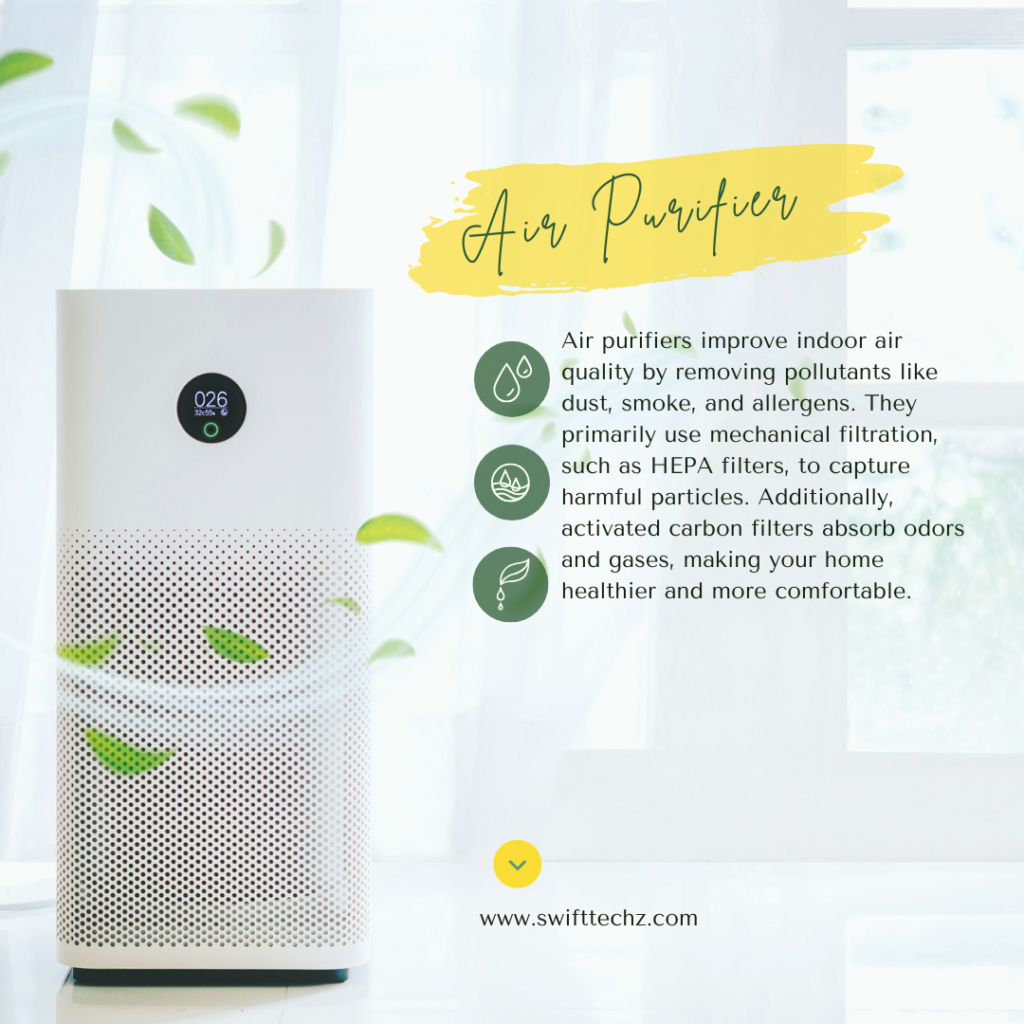Understanding Air Purification: What You Need to Know
Air pollution poses a growing concern, especially indoors where we spend most of our time. To combat this issue, many people are turning to air purifiers. But what exactly is an air purifier, how does it work, and can it effectively eliminate cigarette smoke? This blog aims to answer these questions straightforwardly.

What is Air Purification?
Air purification refers to the process of removing contaminants from the air in a room. These contaminants can include dust, pollen, pet dander, smoke, and volatile organic compounds (VOCs). Additionally, The goal of air purification is to improve indoor air quality (IAQ), making the environment healthier for its occupants.
How Can Air Purification Be Achieved for Air Purifier?
You can achieve air purification through various methods, including mechanical filtration, chemical absorption, and UV light. However, most people use mechanical filtration as the most common and effective method in homes.
- Mechanical Filtration: This involves using filters to physically remove particles from the air. The most recognized type of filter is the HEPA (High-Efficiency Particulate Air) filter. Moreover, HEPA filters can capture at least 99.97% of particles that are 0.3 microns or larger, including allergens and some bacteria.
- Chemical Absorption: Some air purifiers use activated carbon filters that absorb gases and odors. This method is particularly effective for removing VOCs and cigarette smoke.
- UV Light: Certain models incorporate UV light technology to kill bacteria and viruses in the air. While this can enhance purification, it is often not necessary for typical household use.
How Do Air Purifiers Work?
It typically consists of a fan and one or more filters. Here’s a simple breakdown of their operation:
- Air Intake: The fan draws in air from the room.
- Filtration: As the air passes through the filters, pollutants are trapped.
- HEPA Filters: Capture fine particles like dust and allergens.
- Activated Carbon Filters: Absorb odors and harmful gases.
- Clean Air Release: The purified air is then circulated back into the room.
This process continuously cleans the air, ensuring that indoor environments remain healthy.
If you want to read this How to Use Jetson Electric Bike Click Here
Can an Air Purifier Get Rid of Cigarette Smoke?
Cigarette smoke contains a mixture of harmful chemicals and fine particulate matter. This makes it one of the more challenging pollutants to eliminate from indoor air. However, many modern air purifiers are designed specifically to tackle this issue.
- HEPA Filters: These filters can capture larger particles found in cigarette smoke, such as tar and ash.
- Activated Carbon Filters: They are particularly effective at absorbing the gases and odors associated with cigarette smoke.
Research indicates that high-quality air purifiers equipped with both HEPA and activated carbon filters can significantly reduce cigarette smoke in indoor environments.
The Effectiveness of Air Purifiers Against Cigarette Smoke
While no air purifier can eliminate all traces of cigarette smoke, it can substantially reduce its presence in a room. Here’s how:
- Reduction of Particulate Matter: HEPA filters effectively capture fine particles from cigarette smoke.
- Odor Control: Activated carbon filters absorb unpleasant odors, making the environment more pleasant.
- Improved Air Quality: Regular use of an air purifier can lead to noticeable improvements in indoor air quality.
Factors Influencing Air Purifier Performance
When considering an air purifier for cigarette smoke removal, several factors come into play:
- Filter Quality: Look for models with true HEPA filters and activated carbon layers.
- Room Size: Ensure that the cleaner is rated for the size of your room; larger spaces may require more powerful units.
- Clean Air Delivery Rate (CADR): This metric indicates how quickly an air purifier can clean the air in a room. Higher CADR ratings mean faster purification.
Additional Tips for Reducing Cigarette Smoke Indoors
Finally, To maximize the effectiveness of your air purifier against cigarette smoke, consider these additional strategies:
- Designate Smoking Areas: If possible, restrict smoking to certain areas away from living spaces.
- Ventilation: Open windows when weather permits to allow fresh outdoor air to circulate.
- Regular Cleaning: Dust surfaces frequently to minimize residue buildup from smoke.
Conclusion
Air purification plays a crucial role in maintaining healthy indoor environments. By understanding how air purifiers work and their effectiveness against pollutants like cigarette smoke, you can make informed decisions about improving your home’s air quality.
Additionally, Investing in a quality air purifier with HEPA and activated carbon filters can significantly enhance your living space by reducing harmful particles and odors associated with smoking.
In summary, while no solution is perfect, using an effective air purifier alongside good ventilation practices will help create a healthier indoor atmosphere for you and your family,
